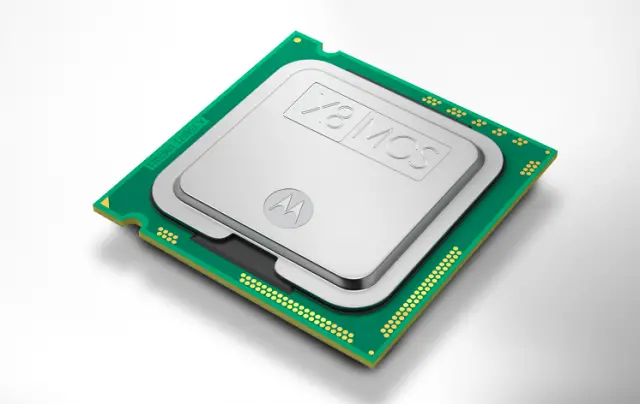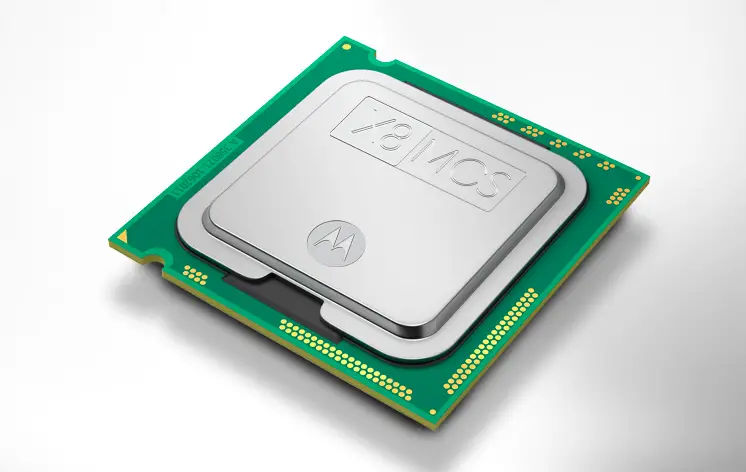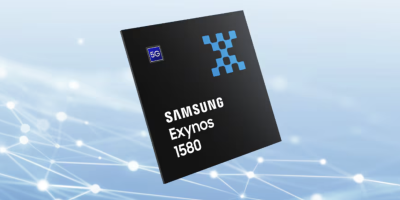
With the announcement of any new Android device comes the hardcore tech crowd who only wants to know one thing: what kind of processor is powering it. By now, you’re familiar with the Snapdragons, Exynos’ and maybe even Apple’s A line which have become a sort of household name in the mobile industry. But then came Motorola who threw everyone for a loop when they unveiled their own specially designed X8 chip, launching soon in the new line of DROIDs and rumored to come inside the Moto X.
So what exactly is the X8? Well, for the core-whores, it sure sounded like some sort of 8-core CPU, and more cores always means better, right? We’re sure this is exactly what Motorola wants you to believe, who went as far as lumping the CPU, GPU, and 2 DSP’s (one acting as a low-power “contextual” CPU to handle sensors, and the other acting as a “natural language processing” for noise cancellation) into the total core count.
Motorola’s senior vice president of engineering, Iqbal Arshad, attempted to explain it as a “cluster” of processors, all working together on individual aspects of the entire system. Motorola’s reasoning behind this was “to move away from a primarily CPU-based architecture to save power and do ‘intelligent, probabilistic computing,'” said Arshad in an interview with PCMag.
More of a processing system than an entirely new SoC, the X8’s actual CPU is none other than the familiar 1.7GHz dual-core Qualcomm S4 Pro with Adreno 320 GPU. While that might sound like last year’s tech to many of you, Motorola assures us that they’ve been doing behind the scenes work to ensure the processor will be all that it can be. The result? Something that could be more than just marketing speak. Arshad goes on to explain:
“We’ve done additional optimizations on top of that such as optimizing the entire Linux user space to move it to an ARM instruction set, cache optimization, Dalvik just-in-time optimization, and we’ve changed the file system. It’s full hardware-software integration to deliver best-in-class performance.”
The best part? While current Motorola X8 devices models are using the S4 Pro, future X8-powered devices are not tied down to this specific processor. Later X8 devices could technically use a CPU from any other manufacturer (or even a more advanced Snapdragon processor). Arshad goes on to say:
“We invented mobile. We have [80] years of DSP expertise, That is all Motorola’s unique technology. If we did not have the contextual computing processor and our natural language processor in place, we would need two additional batteries.”
And it’s not just battery life. Motorola claims the X8 is capable of pushing out a 50% increase in performance over the competition, with better graphic effects and frame rates, making the X8 sounds like a dream come true for causal gamers and those tired of outlet hunting. Motorola also assures us that while the DROIDs aren’t running stock Android, the Moto X should be different, with their Active Display system using the same notification “logic” that is already found in stock Android.
All in all, Motorola’s X8 technology definitely sounds intriguing. Of course, we’ll need to see a few graphical benchmarks and do some battery tests of our own before we believe, in the meantime, you can expect to X8 to be a focal point of the Moto X’s unveiling, only 1 day away. Anyone else excited?







Hopefully it packs a punch! Please please please be pentaband HSPA+ unlocked, a la Nexus 4. A true world phone.
Definitely, we need more of the pentaband love, which Samsung ands HTC did not provide with their ge phones.
Annnnnnnd the pricing makes this thing DOA. What a disappointment.
and all the LTE channels.
No, I can’t say giggity that I am excited giggity at all…
Much like the double rainbow…. what does this mean?!? :P
Raw power isn’t what you want in phones. You want multithreading. We learned this in PCs.
You know, signs are beginning to point to the Moto X being an ON-contract phone.
It’s hard to see them using nearly identical parts in the X as in their Droid lineup, and also selling one for $299 off-contract and all the others at $199 on-contract…
Guess we’ll find out tomorrow.
I sure hope you are wrong about being an “on contract phone”. That would break my heart. I’m out of contract and want to stay that way in case I need to leave Sprint soon.
Not on T-Mobile. :P
I am almost positive sure we’ll see an unlocked version selling at a Nexus-like price point direct through Motorola.
I certainly hope so as well. But, there was someone on a message board who had a friend that’s part of the embargo, and he claimed it was going to be $199 on-contract only — which does make sense given Motorola’s other pricing…
But, you can’t always believe everything you read on the Internet.
I’m rooting for off-contract. :)
Yeah, and with htc one and s4 in play store I imagine a version in the play store as well. There would be no conflict for Google.
Selling the way Google sells hardware? Or actually shipping?
HA! Fair point, but it seems Motorola will be handling this, and not Google which means we’re probably better off :P
the Nexus 4 sells for 300-350 on Google Play while on T-mobile it started at 499( full retail) now its been dropped to 450, at a subsidized price it was about 199$ same as the Droid Ultra, so its still very much possible considering the Droid Ultra and the Moto X have almost identical specs minus the external design.
If we can get this phone on Verizon for a cheap price off contract which will be near impossible it’ll be the phone of the year and people will get to keep their unlimited data for longer thus Verizon keeping old customers
This could be huge for those of us not wanting to lose our unlimited data.
Will it run on AA batteries too?
Until the official announcement and real world tests, I remain skeptical to their claims.
Forgive my cynicism, but when I combine the two quoted paragraphs above, with terms like “best in class” and optimization talks, to me it reeks of marketing hype and build-up before a release. What major Android device OEM hasn’t optimized JIT / cache?
I’m not saying it will be bad by any means, but it could be underwhelmingly good… if that makes sense… :) I’m rooting for this phone, I just worry that everybody’s expectations might be too high. All of these “under the hood” optimizations could be revolutionary, but my gut is telling me they won’t make a noticeable difference in day to day usage.
Finally, a more detailed explanation from Motorola! Now I’m more intrigued to see how the Moto X performs in the real world against the competitors. If they’ve managed to tweak the processor to where they feel it will be competitive than the others, then hopefully those that by the Moto X will have the same/similar experience when we’re discussing the 2014 phones, as to how all the tweaks held up after a full years worth of use.
It sounds like a nice SoC. I hope they don’t pull the same crap Samsung has with the Exynos (not giving developers the SoC documentation, only releasing non-working kernel source, etc). If they do release proper documentation and source, I can see developers doing some really cool stuff with this.
Of course the X Phone will have the X8 processor in it. Once Motorola unveiled the X8 during their Droid launch, all those ‘mysterious’ benchmark results that we’ve been reading about suddenly made perfect sense. Everyone assumed that the CPU would be an S4 Pro, while in reality it’s been the X8 processor all along. What the X8 has in common with the S4 Pro (as well as Snapdragon 400/600/800) is the Krait CPU core, which is architecturally similar to Cortex A15. From what we’ve seen about the X8 so far, it sounds like it’s essentially a chip that combines the Snapdragon 400 CPU, Snapdragon 600 GPU, and a couple of low power dedicated DSP’s for signal processing.
I have to say this this is a very intelligent way to design an all new smartphone. Rather than keep throwing ever more powerful (and power hungry) CPU at the problem, design hardware which allows the processing tasks to be spread out across silicon best suited for the task. In some ways this harkens back to the concepts that the original Amiga computer was based on back in the 80’s, which allowed it to perform graphics and sound operations that weren’t possible on other PC architectures until several generations later.
So far, it looks like this will be a very nicely performing phone, which should also be more power efficient. If Motorola can price it aggressively, they could possibly have a runaway hit on their hands ala the original RAZR.
I miss my Amiga.
They are full of BS. This will be a plain old Snapdragon.
Give the people awesome battery life at an affordable cost on or off contract and without having to buy an extended battery, ala my 5600mAh GS4 battery for special events, then it will be a big hit. Nearly all of my customers today (eBay sales) look for phones with the best battery life first.
“Of course, we’ll need to see a few graphical benchmarks ”
I’m sure Samsung will be more than happy to help you with that…smh at bloggers STILL advocating benchmarks
Just to determine if it can deliver high-frame rates and high-graphics — not to judge real-world, end-user speed. That has a LOT to do with software, and most of the time, isn’t directly related to “cores”.
Hopefully this thing absolutely flys. Can’t wait to see it running. I’d love to see Motorola’s optimization come to life.
Apologies for useless posts like this, but it seems to be the only way that I can log back into disqus, on my phone, when whatever-the-hell logs me out.
…..but does it pour my single malt?
I’m rather interested in the Moto X given this article. If you build software more specifically for hardware ass opposed to forcing generic software onto the same hardware, you can achieve amazing performance if done correctly. Take a look at consoles or even, dare I say it, the iPhone as examples. They can play games well beyond what their specs would lead you to believe. (Granted I know all of them are running 100% native code, as opposed to using a VM).
I’m not saying the tie in of hardware and software on the MotoX is going to be as great as that of say Nintendo, Sony or Microsoft with their consoles, where everything down to the compilers will be written for the specific hardware. However I wonder if Google have done this to show that chasing higher clock speeds and more cores can not only harm battery life but prove to be a more inefficient method of gaining speed than optimising your software for your target hardware.
The only problem with this is that consumers look at specs in terms of numbers, bigger must be better right? Apple have conquered that situation with their unique branding, however Google will have to work hard on the Moto X line to achieve the same results. Here’s to the future however!
“We’ve done additional optimizations on top of that such as optimizing the entire Linux user space to move it to an ARM instruction set”
Wow. So they actually used GCC to compile Linux for ARM? Just like every other Android manufacturer out there?
“cache optimization, Dalvik just-in-time optimization,”
Again, like every Android manufacturer?
“and we’ve changed the file system.”
What’s the new filesystem? They could have changed for worse.
Even if Motorola used a better compiler to compile Linux to ARM in some way that brings superior performance, two things:
1. that is a software improvement, not a hardware improvement
2. it is a software improvement that any other Android manufacturer is equally capable of
Dalvik just-in-time optimization? If that means Motorola has improved the software in some way, see above two points.
Changed the file system? Ditto, see above two points.